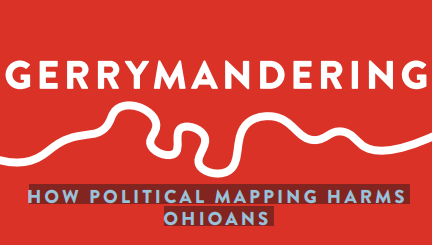Gerrymandering: How political mapping harms Ohioans
Design by Maggie Prosser.
In 2018, the Republican Party held on to 12 of 16 U.S. House of Representatives seats in Ohio, while only winning 52% of the popular vote; Democrats held on to four, and this 12 to four difference has not changed since 2012.
Unequally distributed results like these have happened nationwide. Such an outcome in Ohio is a result of a gerrymandered congressional map drawn by a Republican-dominated legislature in the aftermath of the 2010 midterm elections. Gerrymandering is the process of manipulating the boundaries of congressional districts to favor one political party.
The map was ruled unconstitutional in May 2019 by a three-judge panel for the U.S. District Court for the Southern District of Ohio. The court ordered a new map to be drawn for use in the 2020 election.
“We cannot allow gerrymandered maps to rob Ohioans of their constitutional right to have their voice fairly represented in Congress,” Ohio Sen. Sherrod Brown said in a statement released following the court’s decision.
Less than two months later, the U.S. Supreme Court ruled that federal courts shouldn’t decide federal redistricting cases, meaning the current map will be in place until 2022.
“We have no commission to allocate political power and influence in the absence of a constitutional directive or legal standards to guide us in the exercise of such authority,” Chief Justice John Roberts said in the majority opinion.
This ruling impacted not only Ohio, but also other states such as Wisconsin, North Carolina, Maryland and Michigan. Previous rulings by lower courts attempted to intervene on gerrymandered maps, but the Supreme Court’s decision prevents federal courts’ involvement in political matters, such as gerrymandering.
With that being said, Ohio’s congressional map has a reputation for being gerrymandered. When the map was drawn following the 2010 midterm election, the majority party did what they could to give themselves an advantage, from drawing bizarrely shaped districts to pitting incumbents against each other.
Rep. Jim Jordan, who represents Ohio’s 4th district, has proven to be highly controversial, yet has been reelected every election since 2006 with at least 58% of the vote. His district stretches from Lorain County outside of Cleveland, to down south toward outer suburbs of Columbus and westward past Urbana — within 12 miles of the Indiana border.
Meanwhile, Rep. Marcy Kaptur’s 9th district, also known as the “snake by the lake,” stretches over 100 miles from Cleveland to neighborhoods west of Toledo. When this district was created, it pitted two incumbents, Kaptur and former Rep. Dennis Kucinich, in a reelection battle against each other. Other scrutinized districts include Rep. Marcia Fudge’s 11st Congressional District, as well as Democratic Rep. Tim Ryan’s 13th District.
Athens County is represented by two congressional districts. A small portion of eastern Athens County is part of Ohio’s 6th Congressional District, represented by Rep. Bill Johnson. This district stretches from Lawrence and Scioto Counties in southern Ohio up to Mahoning and Columbiana Counties around Youngstown, in northeast Ohio.
The rest of Athens County is part of Ohio’s 15th Congressional District, represented by Rep. Steve Stivers. This district stretches from Athens to Clinton County near Dayton and up to parts of Franklin County surrounding Columbus. The suburbs of Columbus and central Ohio have vastly different interests from southeastern, Appalachian Ohio. This is just one of a number of problems that are caused by gerrymandering.
“Extreme radical partisan gerrymandering is about politicians picking their constituents,” Kaptur said following the ruling that Ohio’s map was unconstitutional. “In a healthy democracy, constituents should be those who pick their elected leaders.”
In 2018, Issue 1 — a redistricting reform package — passed in Ohio with 75% of voters approving it. Both parties backed the package.
Under the reform package, the district lines have to be approved by 60% of state legislators, and 50% of legislators from both political parties in order for a congressional district map to be approved.
If a map is not approved, the state’s governor, auditor, secretary of state and four lawmakers form a commission to either approve or decline the proposal. If the new map is not approved by the commission, it is sent back to the Statehouse with a lower approval threshold. This would differ from standard guidelines for redrawing districts in other states, where the state legislature has the responsibility of drawing the lines for the governor to approve.
The issue was praised by many in hopes that it will help control gerrymandering in Ohio.
“Partisan gerrymandering has become the unfortunate status quo in the United States, and it’s about time we end this undemocratic practice,” Ryan said, following the decision of the three-judge panel in May. “These unfair maps perpetuate a cycle where districts are drawn to benefit the people in power. Ohio voters should choose their representatives, not the other way around.”

